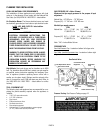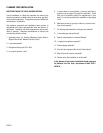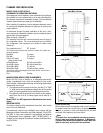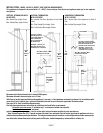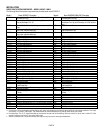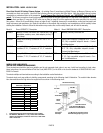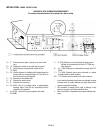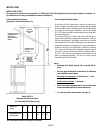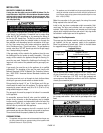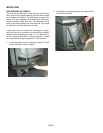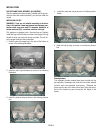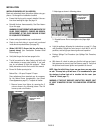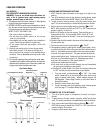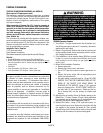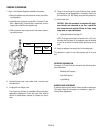
INSTALLATION
PAGE 12
GAS SUPPLY HOOKUP (ALL MODELS)
If using pipe other than black iron pipe see NFPA 54-National Fire Pro-
tection Association / ANSI Z223.1-American National Standards Institute;
and local code for specific requirements for the type of pipe used. Alter-
native gas piping systems such as CSST may be used subject to local
code and proper sizing.
This appliance is equipped with a flexible gas line and fitting for
a gas supply line connection. Connection can be made using
either the 3/8” NPT male fitting or, by removing the fitting, to
the flex line 3/8” female flare. The flex line can be routed to the
gas supply through either the pedestal bottom or through the
rear pedestal cover depending upon the orientation of the sup-
ply line. Some areas may have certain restrictions against the
use of flexible gas lines. Check local codes. The gas appliance
control valve has a 3/8” NPT female type inlet for the gas supply
line, if hard plumbing is required.
If the gas supply will be routed to the appliance from the rear,
the flexible gas line for hookup is readily accessible. If the gas
supply will be routed to the appliance through the flooring, re-
move the rear panel. Redirect the flexible gas line through the
large hole in the center of the pedestal base for gas supply con-
nection.
A gas supply line must be run to the appliance by a qualified
professional. The plumbing of the gas line must comply with
National Standards; NFPA 54-National Fire Protection Associa-
tion / ANSI Z223.1-American National Standards Institute; and
local code.
Gas piping must not run in or through air ducts, clothes chutes,
chimneys or gas vents, dumb waiters or elevator shafts.
Piping should be sloped 1/4” per 15 feet (6mm per 4.6m) up-
ward toward the meter from the appliance. The piping must be
supported at proper intervals every 8 to 10 ft. (2.4m to 3.1m)
using suitable hangers or straps.
The gas supply line must be purged of air before it is connected
to the appliance.
An accessible, approved shut-off valve must be installed up-
stream of any connector so that the appliance may be isolated
to allow service, removal, and replacement (within six feet of the
appliance per NFPA 54, or twelve inches in some codes). A
shut-off valve is provided with this appliance.
IMPORTANT: In case emergency shut-off is required, shut off
main manual gas valve and disconnect main power to appliance.
These devices should be properly labeled by the installer.
PRESSURE TESTING:
• The appliance main gas valve must be disconnected from the gas sup-
ply piping system during any pressure testing of that system at test
pressures in excess of *1/2 psi (3.5 kPa).
• The appliance must be isolated from the gas supply piping system by
closing its individual manual shut-off valve during any pressure test-
ing of the gas supply piping system at test pressures equal to or less
than *1/2 psi (3.5 kPa).
Make the connection to the gas supply line using the correct
fitting required to the shut-off valve.
Install a drip leg where condensates might accumulate. Sedi-
ment traps, like drips and collection tees, are required to be
installed. Traps collect moisture and intercept and hold foreign
objects which might block orifices and valves. A drip leg should
be installed in vertical pipe runs to the appliance.
Supply Line Size Requirements
The proper gas line diameter must be used to run from the sup-
ply regulator (at the gas company meter) to the appliance.
Never use galvanized or plastic pipe. Refer to the table below
for suggested sizing of the gas supply line.
Suggested Sizing of
Schedule 40 Pipe Supply Line
Schedule 40 Pipe
Inside Diameter (Inches)
Schedule 40 Pipe
Length (Feet)
Natural Gas LP. Gas
0-10 1/2 3/8
10-40 1/2 1/2
40-100 1/2 1/2
100-150 3/4 1/2
150-200 3/4 1/2
Use an approved pipe sealant compound for NPT fittings. After
all pipe connections are made, apply normal gas line pressure:
7.0” W.C. for natural gas; 11.0” W.C. for LP gas (propane) and
use an approved leak detection solution to test for the tightness
of each pipe connection joint.
IMPORTANT: All connections must be checked for leaks with a leak detec-
tor or soapy water solution. Never check for gas leakage with an open
flame!
* Note: ½ psi = 14” WC (inches water column).



